Vehicle Racks
Whether you need to take your bikes, snowboards, or canoe along for the ride, there's a vehicle rack to suit your needs.
How to Buy Vehicle Racks
Vehicle racks are a great way to take your outdoor equipment with you and as vehicle models and types of gear become more varied, so do the types of racks. When choosing a vehicle rack the two most important things to know are what kind of rack best accommodates the type of equipment you want to carry and which mount-type best suits your vehicle. Here is a guide to help you become familiar with different types of vehicle racks, how they mount and the different gear carrier types.
Mount Types
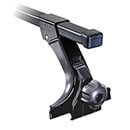
Roof Racks:
Roof Racks are the most common type of racks and usually consist of four towers and varying numbers of crossbars. Different carrying systems can then be attached depending of the type of gear you plan to carry.
- Factory Installed Capable: These racks vary in style depending on your vehicle's existing rack, but are all designed to fit onto the factory-installed rack to provide whatever type of carry rack you're looking for.
- Installed Towers: Usually four raised units that you can permanently mount to your vehicles roof if you don't have a factory-installed rack. They can be combined with crossbars to form a rack style of your choosing.
- Removable Racks: These racks are attached by clips the fit into the top of the door and usually have straps for added stability. They are designed to be just as versatile as permanently-mounted racks, while adding the ability to be removed.
- Strap System: Most commonly used for surfboards or snowboards, strap systems consist of two or more pads and straps that wrap around your vehicles roof and fit through the top of the doors. These racks are easily removed and installed.
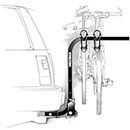
Hitch Mount:
Mainly used with trucks and SUV's, the hitch mount connects to the rear of your vehicle via the hitch receiver or a steel bumper. The hitch mount is a popular bike-carrying mount. Look for a hitch mount that can be moved out of the way when you require access to the rear of your vehicle.
- Vertical-Style: These racks consist of a pole that bends to in an "S-shape" to hold your gear straight-up behind the rear door.
- Tray-Style: These racks usually consist of a flat platform extending from the rear of the vehicle. Though mainly used for cargo, they may also carry bikes other gear
- Receiver Mount: The most common sizes are Class I-II (1 1/4-in x 1 1/4-in) and Class III-IV (2-in x 2-in)
- Steel Bumper: Attaches to a steel bumper with a pin lock
- Fold-Down: These racks and be folded down to allow for access the rear of your vehicle.
- Swing-Away: These racks swing to the side for rear vehicle access.
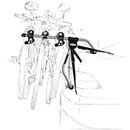
Spare-Tire Mount:
This rack has a mounting plate that fits behind an exterior spare tire and extends through the middle of tire. This rack is most commonly used with SUV's since they require a rear spare tire.
- Removable: Some spare tire-mounted racks can be removed at their base so you don't have to remove the mounting system.
Trunk Mount Racks:
These racks are generally a more affordable type of rack that attaches to your vehicles trunk and is easily removable. A trunk-mounted rack is a good option for people without trailer hitches or exterior spare tires, and for small to midsize cars.
Truck Bed Mount:
These racks systems for pick-up trucks can be installed in the bed to create virtually the same carry options as a roof rack.
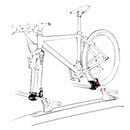
Gear Carrier Types
Bike Carriers:
Probably the most common type of rack, bike carriers vary in both the number of bikes they can hold and in the way they hold a bike. Sometimes up to three different types of holders are combined to secure a bike.
- Rim Mount: The bike is held secure by straps or clamps around the wheel rim. One rim mount is often combined with another type of holder, such as a front fork mount.
- Fork Mount: This mount requires the front wheel to be removed so the fork can be secured to the rack. It's usually combined with some type of rear rim strap or bracket.
- Pedal Crank Mount: This mount is used with roof racks for bikes that have frames that are to difficult to accommodate with a frame holder. It must be combined rim holders.
- Frame Mount: Most rear-mount racks use a frame holding system consisting of some kind of cradles and straps. Roof racks can also use this style when combined with another type of mount.
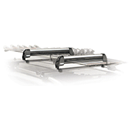
Ski/Snowboard Racks:
With the popularity of snowboarding rapidly rising, ski/snowboard racks have become more versatile and advanced. They are most commonly roof-mounted systems.
- Ski Only Carriers: These units are set-up specifically to carry skis often consist of a strap system that holds each pair on its side.
- Ski and Snowboard Roof Carriers: Most roof ski/snowboard units have a pair of levers that fold down and lock into place to secure your board or skis. Many of these systems can be locked and can accommodate multiple skis or boards.
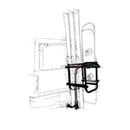
Rear-Mounted Ski/Snowboard Carriers:
These systems hold skis, snowboards or both upright with straps or lever bars.
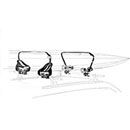
Kayak/Canoe Carriers:
Canoe and Kayak carriers are almost always used with roof systems.
- Saddle System: This consists of four or more padded holders to rest the boat on and is usually combined with straps.
- Roller System: Padded wheels that usually combine with a saddle system to facilitate easy loading and unloading.
- Vertical Support System: This holder combines upright poles with straps to secure a kayak on its side.
- Gunwale Brackets: Padded brackets that are specifically designed to carry a canoe upside down and securely by the gunwales.
Surfboard Carriers:
Board protection is the main concern when choosing a carrier for your surfboard. Most surfboard carriers utilizes and pad and strap system that can either attach to existing roof racks or wrapped around a roof without a rack.
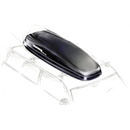
Cargo Carriers:
Cargo carriers are most often used with roof rack systems but some are made for rear-mounted systems as well.
- Basket-Style: This versatile design has an open top and can accommodate a variety of gear. Because of its basket design it's easy to lash items down to.
- Enclosed-Style: This carrier usually boosts an aerodynamic lid and is ideal when you want to protect the contents from rain and snow.